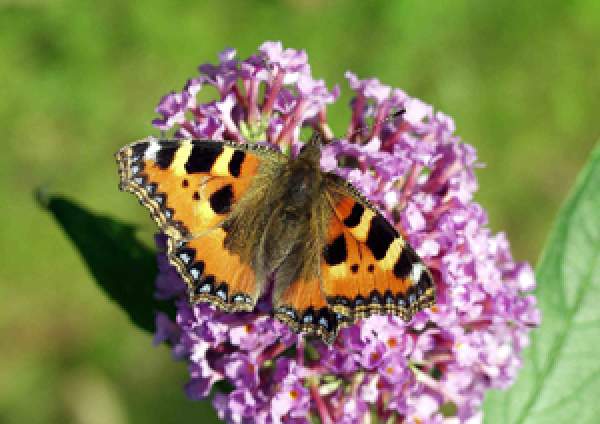Small Tortoiseshell
Aglais urticae

This species should be recognisable to most observers, with both sexes similar in appearance. An unusual colour form (known as semi-ichnusoides) may be encountered occasionally. This forms results when an individual is exposed to high temperatures during the chrysalis stage; it’s appearance shows reduced amounts of orange and the dark spots smudged together, producing a less strongly marked and blurred effect. The camouflaged underwings are useful in concealing individuals that have begun hibernation.
The caterpillars range in colour from black to variegated yellow, with spiky growths emerging at intervals along the back. Even though this colouration deters most predators, a good number of caterpillars are lost to parasitic wasps and flies.
The daily behaviour of males, mentioned briefly above, centres around the need to nectar during the morning and to find a mate. To do this, males will set up a temporary territory, which they will defend for an hour or so. If no female has entered the territory within that time, the male will move on and try his luck elsewhere. Both sexes spend the night deep within patches of nettles and are late risers (typically on the wing from 10am).
Once the weather starts to cool, Small Tortoiseshells look for somewhere warm to hibernate, which may include houses. If you find a Small Tortoiseshell, or any other butterfly species, in your house, don’t leave it there. Once the central heating turns on, it will wake up from hibernation and use up valuable food reserves. However, you should also avoid putting it outside as the cold will kill it. The ideal thing to do is to ‘rescue’ it and place it in an unheated outbuilding or shed. The temperature will remain more stable there and the butterfly should successfully hibernate until the weather becomes warmer again.
Once fertilised, the female will spend the rest of her life searching for suitable sites at which eggs can be deposited. The females lay their eggs during the afternoon, selecting patches of young nettles in sheltered but sunny locations. Both common and small nettle are used as a food plant by the caterpillars, but the females reject most clumps as being too small, too sheltered or not young enough. An ideal nettle bed is one that occupies a large part of a sunny border, and which has been cut in early June to promote tender regrowth – not exactly the sort of thing tolerated by many gardeners.
Because the eggs are laid in groups, the caterpillars are initially gregarious, living within an untidy web. When they are nearly fully-grown, they will disperse and live singly, still on nettle. This stage may last for about four weeks from egg to pupa. If you encounter a Small Tortoiseshell fluttering about in your centrally-heated house in the later part of the year, then ‘rescue’ it to an outbuilding or shed (and not outside) where the temperature will remain more stable and help secure a successful hibernation.
Although this species remains common and widespread, there has been a slight long-term decline in abundance over the last few decades.






Share this page